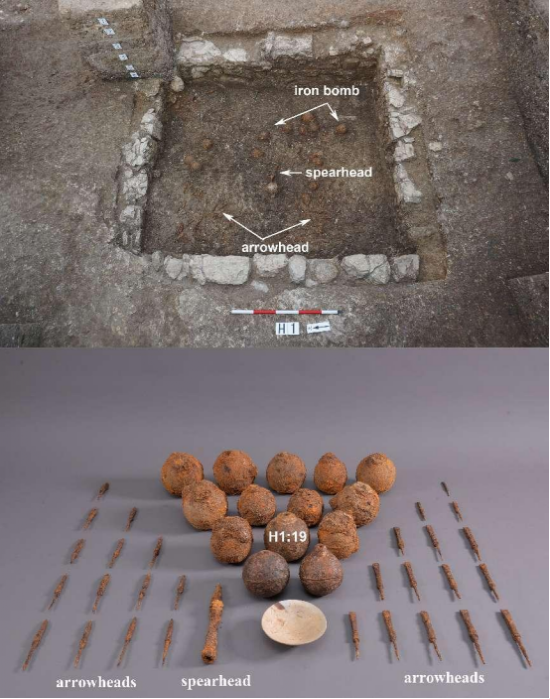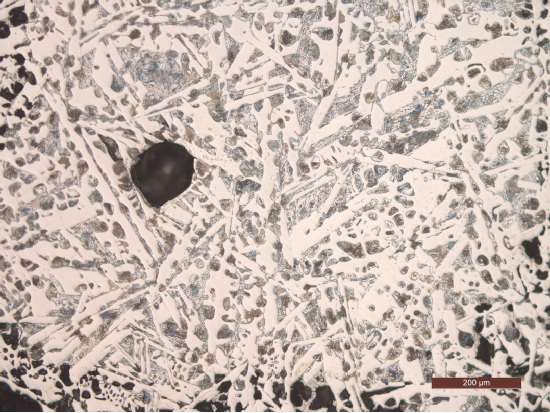The archaeometallurgy team published an article in Archaeological Research in Asia titled 'The earliest iron bomb unearthed from the Baidicheng site in Chongqing.'
Recently, the metallurgical archaeology team of Professor Yingfu Li from the Center for Archaeological Science, Sichuan University, in collaboration with the Chongqing Municipal Institute of Cultural Relics and Archaeology, conducted research on the manufacturing technology and historical background of iron bombs unearthed from the Baidicheng fort site in Fengjie, Chongqing, with the title "The earliest loaded iron bomb excavated from the Baidicheng fort site Chongqing, China." The article was published in Archaeological Research in Asia. Houxi Zou, Chongqing Normal University and Chongqing Municipal Institute of Cultural Relics and Archaeology, is the first author of this article, and Professor Yuniu Li from the Center for Archaeological Science is the corresponding author. Zhigang Sun, Associate Research Librarian, Lin Ye, Associate Research Librarian, and Dadi Li, Research Librarian, from the Chongqing Municipal Institute of Cultural Relics and Archaeology, Professor G. Juleff from the University of Exeter, Professor Yingfu Li from the Center for Archaeological Science, and doctoral student Wan Huang are co-authors of this article.
In 2017, the Chongqing Institute of Cultural Heritage (now Chongqing Municipal Institute of Cultural Relics and Archaeology) discovered 17 iron bombs at the H1 site of the Fanjiatai site in Ziyang City and the CM2 site of the Huangdiantai site in Baidicheng, Fengjie County, Chongqing. Among them, 16 iron bombs were unearthed from H1 and 1 from CM2 (Figure 1 and Figure 2). Archaeologists systematically tested 17 iron bombs, and one iron bomb (numbered CM2鈶�: 9) discovered at the Huangdiantai site was filled with gunpowder. The iron bombs unearthed from the Baidicheng site are not only large in quantity and well-preserved, but also have clear provenance and age. In particular, CM2鈶�: 9 is not only the world's first discovered iron bomb filled with gunpowder, but also the earliest gunpowder object discovered in the world so far, which is of great academic significance to the study of the composition, energy, and the era and route of gunpowder's westward transmission in early China.
The iron bombs were unearthed from H1 of T9 in Ziyang City. According to the excavation, H1 was originally a water storage pool, which was turned into a backfilling pit after the Song army surrendered, possibly to prevent weapons from falling into the hands of the Yuan army. Iron arrowheads, iron bombs, copper crossbows and other weapons were scattered and piled at the bottom of the pit, and the upper part was covered with stones and mud. H1 is superimposed under the Yuan Dynasty silt layer, and objects such as white glazed porcelain bowls and celadon pottery jars from the Southern Song Dynasty were unearthed in the pit. A total of 5 dating samples (1 animal bone, 4 charcoals) were collected from the ash pit for carbon-14 dating. The results showed that the absolute age of H1 was between 1042-1275 AD (2蟽), which is basically consistent with the archaeological judgment and belongs to the late Southern Song Dynasty and early Yuan Dynasty.
The metallurgical archaeology team of the Center for Archaeological Science conducted a comprehensive and in-depth study on one of the iron bomb samples (SK0113). According to the remaining parting line marks on the surface of the iron bomb and the shape of the pottery mold found in the past, it can be seen that the iron bomb was cast in one go with molten iron using two semi-circular pottery molds. According to the microscopic analysis results, the iron bomb is about 8mm thick, and there is a rust layer of about 2mm thick on the outer surface. The outer shell of the iron bomb is hypoeutectic white cast iron, and the matrix is pearlite and ledeburite (Figure 3). The ion chromatography test results of the liquid sample in the provenance of the iron bomb show that the original environment should contain sulfur (SO42-: 0.57mg/mL). The Shanghai Institute of Optics and Fine Mechanics of the Chinese Academy of Sciences conducted Raman spectroscopy tests on the fillings in CM2鈶�: 9 and found minerals of sulfur, carbon, and iron, gypsum, and very low potassium content. When taking out the filling, we conducted an open flame ignition experiment. When a lit match was brought close to the sample, obvious spark splashes could be observed above the sample.
After the Mongol (Yuan) army occupied the north, from 1234 to 1279, they began to implement the strategic goal of occupying Jianghuai and unifying the country. The Southern Song army gradually retreated in the process of fighting against the Mongol army, and gradually formed a system of defending the upper reaches of the Yangtze River to consolidate the defense of the lower reaches. Baidicheng in the Song Dynasty was the core of this defense system. The Song-Mongol War in Baidicheng was a major event in the history of the Song and Yuan Dynasties in China, and is repeatedly mentioned in documents such as the History of Yuan, the Political Essentials of the Three Dynasties of the Song Dynasty, and the History of Song. The defense of Kuizhou Road began in 1234. In 1278, the Yuan army in Sichuan and Hubei joined forces under Baidicheng, and the Song army in Kuizhou was forced to surrender. The war lasted for nearly 44 years. The age of H1's burial is basically consistent with the age of this historical event. Baidicheng, as the last line of defense of the Southern Song Dynasty, was not captured until the Chongqing Prefecture of the Sichuan System Office, the command center of the Sichuan war zone, surrendered. The application of iron bombs may have played a great role in the defense war. The discovery of iron bombs in Baidicheng is the first-hand physical data of iron bombs in the Southern Song Dynasty, which provides valuable data for in-depth discussion of military history and science and technology history in the 13th century, and is of extremely important academic significance.

Figure 1 Location Map of Baidicheng Site

Figure 2 Main Unearthed Relics of H1 (Above) at Baidicheng Site (Below)

Figure 3 Metallographic Photo of Unearthed Iron Bomb (Ledeburite and Pearlite)
